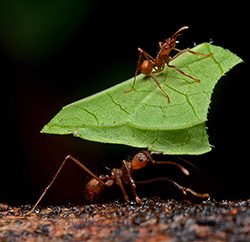
Illustrated by: James Baxter
show/hide words to know
Many animals survive by living in large communities. They rely on each other to survive and depend on cooperation among the community members.
Ants are great examples of how individuals in a group can work together to protect the survival of the community. How do they do this? Well, ants have specialized jobs or tasks within the colony. (Bee colonies are similar in that way.) What makes a large community so successful is its ability to work as a system.

Through research and games, you will learn how the different castes of leafcutter ant work together to provide for the colony.
However, not all ants will function the same way. The strategies that different species (even different leafcutter species) use to obtain the four requirements for survival—water, food, shelter, and space—can be different.
What You Need
Make sure to get the following from your teacher:
- Leafcutter ant vocabulary crossword puzzle
- Diagram of leafcutter ant with labeled body parts
- Blank diagram of leafcutter ant
- Various pictures of leafcutter ants
- Center directions
- Leafcutter relay handout
- Green construction paper
- Scissors
- Markers or crayons
- Leafcutter ant photos
You will also need:
- Classroom computers or laptops
- Pencils
Before You Begin

Think about what you know about ants and about the life of an ant.
Over the next three days you will be working in groups of 3-4 to research the caste system of the leafcutter ant and how they make sure they have the essentials of survival: water, food, shelter, and space.
Work cooperatively with your group and follow your teacher's directions. Be sure to record all of your work in your notebook. Each member of your group is accountable for participating and contributing to your research.
Always clean up materials at the end of the day, leaving them the way you found them.
Procedure
Day 1: Watch and Play
While watching the video Leafcutter Ants in the Panama Rainforest(link is external) you will take notes and record your data for the following items:
- Name two of the ant jobs you hear the video mention.
- List 4 facts that you learned from the video.
- Write down 2 questions that you have after watching this video.
Play and analyze: Leafcutter Relay
As a class, you will complete the Leafcutter relay. Afterward, you will analyze the interactions of your group.
What would happen if something were to alter the leafcutter system?
What events might disrupt the ant colony and what effect would it have on the colony in the long run?
Day 2: Web research—Community
- Read the Ask A Biologist story "A Closer Look at Castes."
- Create a data table that shows the different castes of ants living in a leafcutter ant colony.
- Add illustrations and definitions to the table to demonstrate your knowledge of the leafcutter ant’s caste system.
Day 3: Web research—Ask a Biologist
Complete the crossword puzzle by reading the articles “Secrets of a Superorganism” and “Leafcutter Ant Colony.”
- Begin by completely reading the article as a group.
- Afterward, read the questions on the crossword puzzle and then read the article again, noting where you found potential answers or useful information within the text.
Or
Jigsaw the article: Assign different questions to different members of your group. If you jigsaw this assignment, make sure to discuss as a group where each answer was found.
Repeat for the second article and for any information in "A Closer Look at Castes," which you read on Day 2.
Day 4: Does an ant have knees?
- Label the anatomy (different body parts) of an ant. Clearly label and color the diagram.
- Think about the question "Does an ant have knees?" Record your answer in your notebook.
- Work with your group to record definitions to the following vocabulary terms: Brood, caste, colony, division of labor, forage, larva, organism, pupa.
Day 5: Create Your Own Diagram
- Review all the research your group has completed over the course of the week.
- Based on the research you have completed, work as a group to illustrate and diagram a leafcutter ant colony. If you were to find a colony in the rainforest, what might it look like? What features would it have? What is the environment like and how does that affect the ant colony? Consider the different castes of ants living in the colony and their jobs. Remember to consider the four essentials to life: water, food, shelter, and space.
- Make sure your work is neat, easily read and understood, labeled when needed, and matches with the research you have completed. Be able to justify your diagram with evidence.
- Work on your illustrations for an additional day if needed.
Angelina Alameda is a graduate of Arizona State University with a bachelor’s degree in Elementary Education.
Additional images via Wikimedia Commons. Foragers with guard ants by Geoff Gallice.
View Citation

Learn more about leafcutter ants by reading the companion article, Secrets of a Superorganism.
Download the Life of a Leafcutter Experiment Packet [PDF].
Be Part of
Ask A Biologist
By volunteering, or simply sending us feedback on the site. Scientists, teachers, writers, illustrators, and translators are all important to the program. If you are interested in helping with the website we have a Volunteers page to get the process started.








